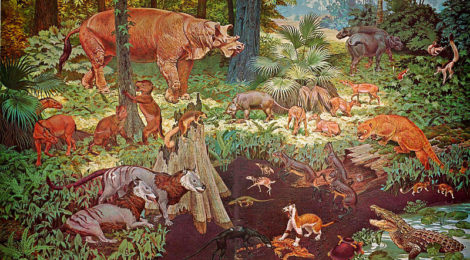
Prehistoric Great Warming Caused By Loss of Plankton Cooling
As reported in Journal Nature CO2 warming was insufficient to produce the Great Warming 55 million years ago
The high CO2 of that age produced lush green land, but more grass growing meant less dust blowing
Diminished dust collapsed ocean pastures and plankton cooling – a force of nature far more powerful that CO2 radiative warming
In this report in the Journal Nature what’s been left out, aka ocean ecology, is vital and herein restored
Climate scientists have always made use of the example of the Paleocene–Eocene Thermal Maximum (PETM), aka The Great Warming, which occurred some 55 Myr ago in their prognostications about global warming and climate change. The ancient time of dramatic global warming with increasing atmospheric CO2 has been repeatedly used as an example of our present fossil fuel age of globally warming climate coinciding with high and rising CO2 emissions. Studying the ‘the great warming’, provides clues as to what drives our blue planet’s climate system, both primary drivers and powerful feedback mechanisms it seems are vital.
A study reported in Nature Geoscience, found that CO2 forcing alone has proven to be wholly insufficient to explain ‘the great warming’. The boffins, using a sophisticated new global warming computer simulation, speculate that powerful feedbacks, hitherto scantly or not reported, must have been a vital and substantial part of the warming.
Quite simply they state, CO2 did NOT alone cause the PETM climate change.
In an article entitled “Carbon dioxide forcing alone insufficient to explain Palaeocene–Eocene Thermal Maximum warming,” Richard E. Zeebe, James C. Zachos and Gerald R. Dickens state:
“The onset of the PETM was marked by a global increase in ocean/surface temperatures by 5–9 °C within a few thousand years. At nearly the same time, a substantial carbon release occurred, as demonstrated by a large drop in the 13C/12C ratio of surficial carbon reservoirs.”
In today’s context many reports estimate the carbon (CO2) release during the onset of the PETM and emissions from recent anthropogenic sources over the past 50 years seem to be of a similar order of magnitude (~1 Pg C y-1, that’s 3.6 billion tonnes of CO2 per year.)
Some scientists think that the PETM was triggered by a sudden massive injection of CO2 into Earth’s atmosphere. Using deep-sea carbonate dissolution records and stable carbon isotope records across the PETM, in combination with carbon cycle modeling, the authors arrived at an estimate of the amount of carbon released during the PETM. They used the long-term ocean–atmosphere–sediment carbon cycle reservoir computer model LOSCAR to constrain the total mass of the carbon input.
A Simple Ocean Pasture Ecology Explanation – Plankton As A Force Multiplier
Interestingly, there were “profound differences” in observed the prehistoric and tiny Atlantic Ocean and the vastly larger Pacific Ocean carbon sequestration in the sea during the event. This was detected by variation in the calcite compensation depth (CCD) in the different ocean basins.
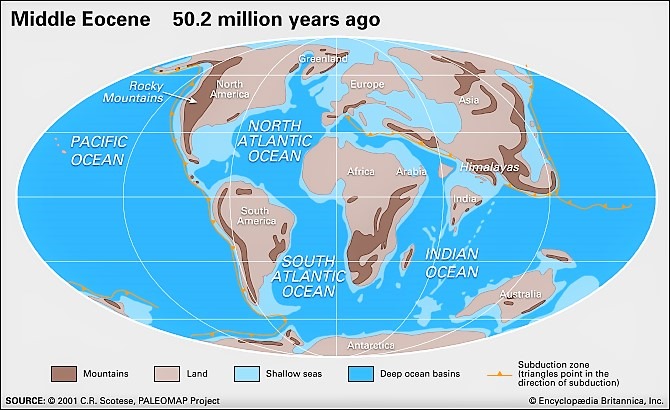
The Paleocene Pacific Ocean was more than 10 times the size of the tiny Atlantic Ocean and it’s ocean pasture plant life was the principal force of Nature controlling ocean and global temperatures of the time. Collapse of its Plankton Cooling potency sent the entire planet into the Great Warming. – click to enlarge
Ed. comment: The tiny and relatively shallow Atlantic Ocean (at that time) showed high rates of deposition while the vast deep Pacific Ocean showed much lower amounts. In effect the tiny Atlantic ocean pastures with access to vital mineral micronutrients remained blooming while the vast Pacific, the largest of the world’s oceans lost its mineral dust. The high CO2 of the epoch grew thick vegetation on land which stopped dust from blowing in the wind.
The simple ecological phenomenon that was prominent during the PETM epoch and is once again occurring in our world today is global greening which reveals the simple lesson/meme,
more grass growing means less dust blowing.
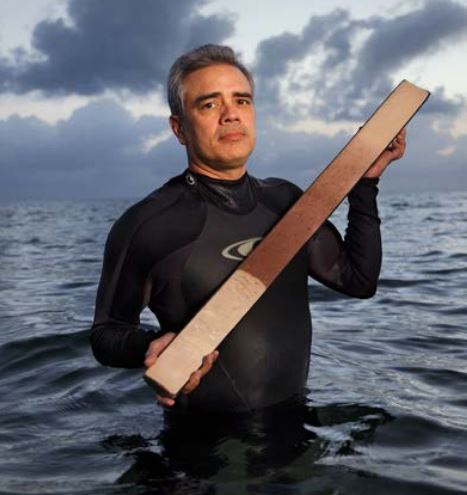
Paleoceanographer James Zachos with a sediment core shows abrupt change ocean phytoplankton 56 million years ago, at the onset of the Paleocene-Eocene Thermal Maximum (PETM). White plankton shells vanished from the seafloor mud, shifting its color from white to red.
During the Paleocene/Miocene epoch the Pacific Ocean was keeping the blue planet cool but as it lost its dust, plankton, and plankton cooling it rapidly became a clear lifeless blue desert. The importance of this plankton cooling effect, the most powerful force of Nature on this (and any blue planet, take Venus for instance) was well described in what has become a text book of climate change and this chapter.
The authors of this new paper concluded that the maximum initial carbon input is constrained to approx 3,000 Pg C (Pg stands for peta gram, which is the same as ~10 trillion metric tons of CO2.) This estimate of the maximum initial carbon input was also found to be largely independent of its duration, meaning whether it happened in a single giant blast or over 5,000 years made no difference to the simulation response.
The authors, mystified with their results, have mused that the pattern of the carbon input scenario required by the model to match observations might be consistent with a pulsed input pattern of carbon release from oceanic gas hydrate reservoirs—in other words, an eruption of ocean floor methane. Although sustaining the mystery, direct evidence of such a methane outburst is missing.
Puzzling Enigma Points To Loss Of Plankton Cooling
There is plenty of evidence that Earth’s climate underwent a significant rapid warming, lush growth of vegetation, and related effects. What is most interesting and puzzling to the authors, as they report, was that the warming that occurred could not have been caused by the radiative warming effect resulting from the amount of CO2 the researchers’ study found.
The authors state that using the accepted equilibrium climate sensitivities of 1.5–4.5 °C warming per doubling of CO2, our calculated 1.7-fold increase in CO2 would at most have caused ~3.5 °C warming during the PETM main phase. This constitutes an enigma because proxy records globally indicate far greater surface warming by 5°–9 °C. If the temperature reconstructions are correct, then feedbacks and/or forcings, aka a CO2 Force Multiplier, other than atmospheric CO2 caused a major portion of the PETM warming.
This fine paper delivers more evidence that CO2 on its own, as a greenhouse gas, is not a powerful enough force of Nature to cause the magnitude of temperature change that took place during the PETM. Once again, if CO2 is to be the driver of climate change it must be acting through a force multiplier and clearly the only such force multiplier is solar powered ocean photosynthesis or lack thereof.
The authors’ clearly show the evidence for the sudden pulse of CO2, equivalent to 1,000 years of human emissions at current rates, could not have caused the PETM. Add to that the fact that the atmosphere at the end of the Paleocene started with more than twice the amount of atmospheric CO2 as Earth’s current atmosphere.
“Undoubtedly, the climatic boundary conditions before the PETM were different from today’s—including different continental configuration, absence of continental ice and a different base climate, which limits the PETM’s suitability as the perfect future analogue,” state the authors, somewhat disappointed at not finding a clear link to CO2 and modern global warming.
“Nevertheless, our results imply a fundamental gap in our understanding of the amplitude of global warming associated with large and abrupt climate perturbations. This gap needs to be filled to confidently predict future climate change.”
The importance of CO2 acting through its most simple radiative heating mechanism has been persistently overstated by mainstream climate scientists. But CO2’s importance and potency when acted upon via the force multiplier effect of ocean pasture photosynthesis is demonstrably more than sufficient to account for both the Great Warming of the PETM and the present day loss of ocean plankton cooling which is in turn responsible for global warming.
It is vitally important that we understand the real pathways and mechanisms of our CO2 driven climate change to be first and foremost driving ocean change.
The cost and time required to mitigate CO2 effects in the atmosphere and climate are surely the many trillions of dollars and scores of years agreed to by 197 Nations in the Paris Climate Accord. But when taking advantage of the force multiplier power of our greatest allies, the phytoplankton of the seas, we can immediately restore and regenerate ocean plankton cooling and help let Nature do the heavy lifting all at a cost of mere millions each year solving the global crisis over the course of just a few years.
Join me the work has already begun!
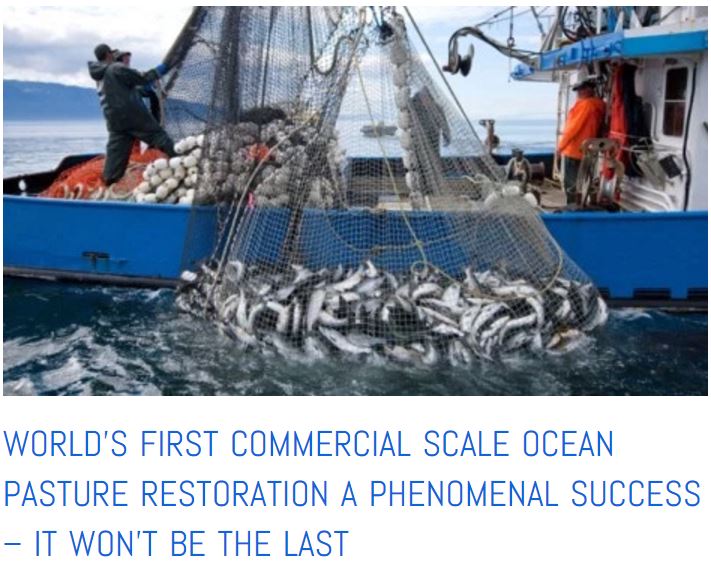
In my 2012 restoration of just one modest ocean pasture of 50,000km2 in the Gulf of Alaska a blue desert ocean was restored to the equivalence of the Garden of Eden. Testifying to this were hundreds of millions of additional salmon that survived and thrived on their regenerated ocean pasture. – click to read more









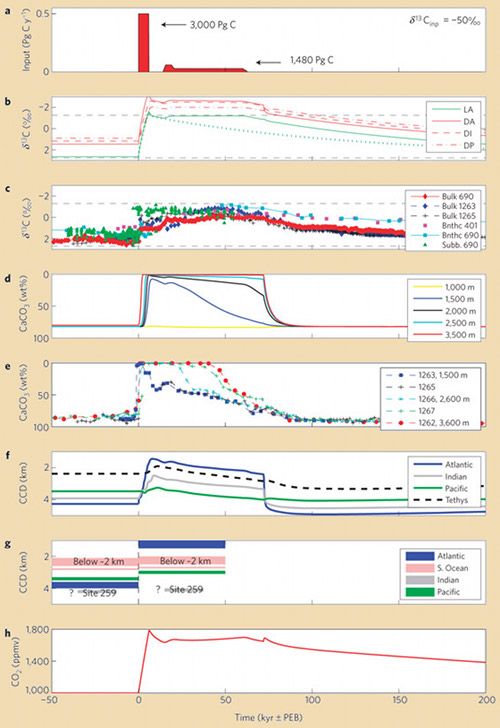
This deap Earth history research has to shake us into reality. Furthermore to have these powers of science makes our use of fosil energy more absurd. We are brilliant fools and ignorant jerks to turn our backs on reality for the last drop and lump. California Burning Louisiana Drowning